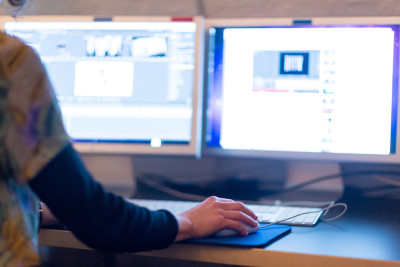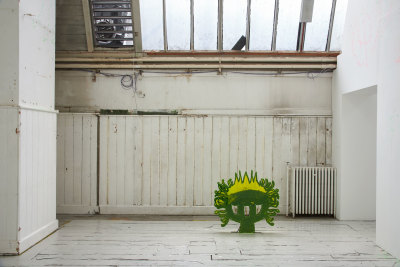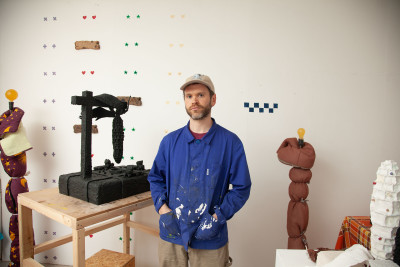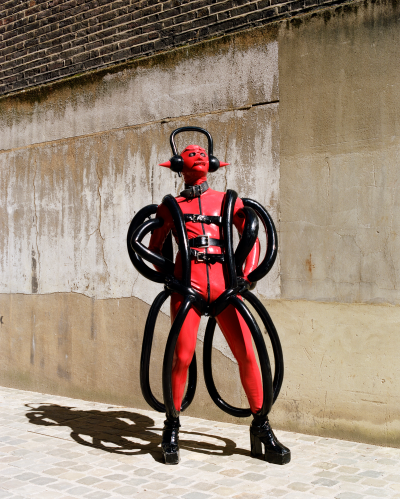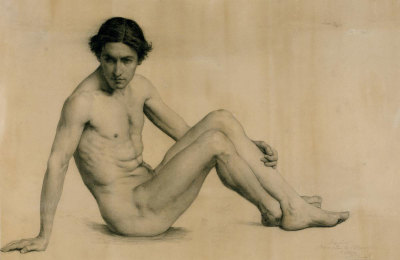Ancient and modern
Ancient and modern
Printmaking in the RA Schools
By Tom Jeffreys
Published 14 April 2014
From traditional engravings to cutting edge digital techniques: the RA Schools is a hive of creative approaches to printmaking.
-
With the chiaroscuro woodcuts currently on show in Renaissance Impressions receiving widespread critical acclaim, interest is rising in one of the most traditional of printmaking techniques. Meanwhile, just a few yards away – along a few corridors and through a few doors – the staff and students in the RA Schools are using print in ways that would have been unthinkable to chiaroscuro pioneers of the sixteenth century such as Ugo da Carpi or Hendrick Goltzius.
The RA Schools offers the only three-year postgraduate art programme in Europe. Not only is it free but there is also no curriculum: this means that the Schools are able to offer a programme that responds to the individual needs of each students. “We teach fine art rather than discrete disciplines,” explains artist Mark Hampson, Head of Material Processes at the Schools. The result of this non-departmental approach is a great deal of overlap between different printmaking processes and techniques. This is extremely important, argues Print Tutor, Hen Coleman: “Traditional processes are being reinvigorated by digital practice and new material developments”, she says. “So you now see an increasing number of hybrid prints appearing that don’t adhere to the traditional categories.”
This hybrid approach – sometimes known as ‘tra-digital’ – is crystallised in the practices of both Coleman and Hampson. Coleman works primarily across painting and drawing but is currently engaged in producing a set of small-scale etchings for a pop-up show in Soho at the end of April. Hampson, meanwhile, is working on a series of fantastical portraits of artists that never existed, playing on archetypical artistic personalities. “The works,” explains Mark, “are anachronistically confusing.” Each image is produced by drawing over inkjet prints from engraved illustrated sources. As Mark puts it: “they’re rooted in Victorian and Georgian illustrated engravings, but with a contemporary, hand-drawn, jaundiced twist. I’ve always been interested in how you can knock things out of time, igniting history with the contemporary, and I think the various processes involved in print-making – especially digital technologies – are an important part of that.”
-

Mark Hampson, Art Lovers.

Mark Hampson, TittiRetto.

Mark Hampson, Goymauier.
-
Likewise, several current students are reaping the benefits of incorporating printmaking into their practice. Rebecca Ackroyd, for example, has incorporated printmaking into sculptural pieces; Caroline Abbots has applied photo emulsion and pigments onto glass; and Hannah Perry has brought printmaking into her multimedia installations. “We’re not traditional,” continues Coleman. “We just apply print to surfaces: be it cloth or paper or plastic or mirror. It’s an experimental approach to printmaking. We try things and see what happens.”
-

Caroline Abbotts

Rebecca Ackroyd
-
An important part of this experimental approach is an embrace of new technology. In particular, Mark credits the ongoing relationship between the Schools and Epson. This relationship centres on the purpose-built Epson Suite, which includes AV projection technologies as well as the company’s full range of Stylus Pro large format inkjet printers. “We’re encouraged to be experimental,” says Mark, “to use the machines against function – even if it means we end up breaking them. Every student will use the suite at some point, whether it’s for production, documentation or research. If the Life Room is the heart of the RA Schools, then the Epson Suite is its brain. It’s a vital organ in the life of the Schools.”
-

At work in the Epson Suite

Maciej Urbanek at work in the Epson Suite
-
Despite this enviable freedom, printmaking nevertheless entails a certain amount of technique, and students benefit from an impressive array of tutors and fellows. In 2012 the Schools were able to appoint two Epson Digital Media Tutors – currently Barton Hargreaves and Guler Ates. At the other end of the modernity spectrum, there are also fellows to aid with more traditional printing techniques such as etching, which has been around for hundreds of years.
Etching Fellow Beatrice Haines is here in the Schools every Wednesday to help students or other members of staff. “The Schools students are not necessarily printmakers per se,” she explains, “they use printmaking and work it into their practice – it’s something that is happening more and more in the wider art world. As an artist you can dip in and out of a particular process. Of course that means that sometimes you might need help with a particular set of skills, and I’m here to help the students both technically and conceptually.”
-

Hen Coleman, Print Tutor

Beatrice Haines and Hen Coleman at work in the Etching Studio

Beatrice Haines, Etching Fellow
-
At the same time, the position is just as much about developing the practice of the fellow. Haines is currently working on a new series of monoprints that will go on show for the first time at London Original Print Fair here in the RA’s Main Galleries. She has chosen to approach her fellowship at the Schools as if it were a residency, and is producing work that responds to the history of the site itself. Dust from under some of the sculptures in the historic cast corridor is dropped onto the plate and printed directly onto paper. “What I love about this approach,” she says, “is the immediacy and the directness of contact – as if the object is leaving some of its soul on the paper.”
Like both Coleman and Hampson, Haines’ own practice is diverse, and takes in drawing, video, installation and more. “My work is often aesthetically extremely varied,” she says, “but the conceptual basis remains fairly consistent.” And this basis is, in a way, printing itself: “my work focuses on the human trace,” she explains. “The first image I ever made was of a piece of carpet with an imprint in it, from where my grandmother used to sit every day and brush her hair. I’m very interested in forensics, and printmaking feeds into that – the feeling, like a fingerprint, of something left behind.” It’s the same basic instinct – to use one surface to make a mark on another – that has always underpinned printmaking: from chiaroscuro woodcuts to the very latest in digital innovation.
-
#PrintMonth
To celebrate a triple whammy of print-related exhibitions here at the RA, we’ve designated April as Print Month. Alongside a wealth of articles, image stories and videos, we’re encouraging everyone to get involved via social media. Whether on Facebook, Twitter, Pinterest or Instagram, we’ll be sharing print-related material throughout the coming weeks, using the hashtag #PrintMonth. Feel free to share your favourite prints and printmakers, or ask us any print-related questions you might have. We’ll be sure to speak to one of our printmaking experts here at the RA and get back to you with the best answer we can.
Renaissance Impressions is in the Sackler Galleries until 8 June 2014.
Norman Stevens ARA is in the Tennant Gallery until 25 May 2014.
London Original Print Fair is in the Main Galleries, 24 - 27 April 2014.





